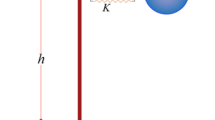Abstract
In this investigation, attempts are made to examine the effects of soil-structure interaction on the deflection modification factor of multistory buildings and to clarify the role of deformable soil on this factor. A comprehensive study is conducted to investigate the effect of inertial interaction on displacement demand ratios in soil-structure systems with different structural characteristics and various non-dimensional parameters, using a simplified interacting model. A two-step regression analysis of the nonlinear, dynamic computer simulation results obtained, leads to a reliable and accurate formula for predicting deflection modification factors that incorporate foundation flexibility. The results illustrate that the application of deflection modification factors derived from fixed-base structures can lead to unsafe evaluation of the structures on soft soil. The proposed formula provides a useful tool for design engineers to incorporate the effect of soil–structure interaction into the evaluation of structural deformations.
Similar content being viewed by others
References
ASCE/SEI 7-10 (2010), Minimum Design Loads for Buildings and Other Structures, American Society of Civil Engineers.
Avilés J and Pérez-Rocha LE (2003), “Soil-structure Interaction in Yielding Systems,” Earthquake Eng. Struct. Dyn., 32: 1749–1771.
Avilés J and Pérez-Rocha LE (2005), “Influence of Foundation Flexibility on Rµ and Cµ Factors,” Journal of structural engineering, 131(2): 221–230.
Bielak J (1976), “Modal Analysis for Building-soil Interaction,” Engineering Mechanics Division, ASCE 102(5): 771–786.
Bielak J (1978), “Dynamic Response of Nonlinear Building-foundation Systems,” Earthquake Eng. Struct. Dyn., 6: 17–30.
Chopra AK and Gutierrez JA (1974), “Earthquake Response Analysis of Multistory Buildings Including Foundation Interaction,” Earthquake Engineering Structure Dynamics, 3: 65–77.
FEMA 450 (2003), NEHRP Recommended Provisions and Commentary for Seismic Regulations for New Buildings and Other Structures, BSSC, WA.
FEMA 440 (2005), Recommended Improvements of Nonlinear Static Seismic Analysis Procedures, Applied Technology Council, CA.
Ganjavi B and Hao H (2011), “Elastic and Inelastic Response of Single- and Multi-degree-of Freedom Systems Considering Soil Structure Interaction Effects,” Australian Earthquake Engineering Society Conference, Barossa Valley, South Australia.
Iguchi M (1978), “Dynamic Interaction of Soil–structure with Elastic Rectangular Foundation,” Proceeding of the fifth Japanese Earthquake Engineering Symposium, Tokyo, Japan, p. 457–464.
Jennings PC and Bielak J (1973), “Dynamics of Building–soil Interaction,” Bull. Seismol. Soc. Am., 63(1): 9–48.
Medina RA and Krawinkler H (2003), “Seismic Demands for Non-deteriorating Frame Structures and Their Dependence on Ground Motions,” John A. Blume Earthquake Engineering Center, Department of Civil & Environmental Engineering, Stanford University, Report No.144.
Meek W and Wolf JP (1993), “Why Cone Models can Represent the Elastic Half-space,” Earthquake Engineering and Structural Dynamics, 22: 759–771.
Meek W and Wolf JP (1994), “Material Damping for Lumped-Parameter Models of Foundation,” Earthquake Engineering and Structural Dynamics, 23: 349–362.
Mylonakis G and Gazetas G (2000), “Seismic Soil–structure Interaction: Beneficial or Detrimental,” Journal of Earthquake Engineering, 4(3): 227–301.
Priestley MJN and Park R (1987), “Strength and Ductility of Concrete Bridges Columns under Seismic Loading,” ACI Structural Journal, 84(1): 61–76.
Veletsos AS and Meek JW (1974), “Dynamic Behavior of Building–foundation Systems,” Earthquake Eng. Struct. Dyn., 3: 121–138.
Veletsos AS and Verbic B (1974), “Dynamics of Elastic and Yielding Structure–foundation Systems,” Proc., 5th World Conf. Earthquake Engineering, Rome, Italy, p. 2610–2613.
Wolf JP (1994), Foundation Vibration Analysis Using Simple Physical Models, Englewood Cliffs (NJ): Prentice–Hall.
Wolf JP (2004), Foundation Vibration Analysis: A Strength-of-Materials Approach, Butterworth- Heinemann.
Author information
Authors and Affiliations
Corresponding author
Rights and permissions
About this article
Cite this article
Abedi-Nik, F., Khoshnoudian, F. Deflection modification factors of multistory buildings considering soil-structure interaction. Earthq. Eng. Eng. Vib. 14, 561–570 (2015). https://doi.org/10.1007/s11803-015-0045-y
Received:
Accepted:
Published:
Issue Date:
DOI: https://doi.org/10.1007/s11803-015-0045-y




